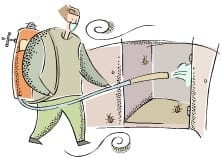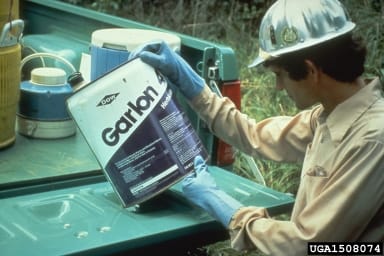Pesticide Definitions taken from
Insecticide Basics for the Pest Management Professional
Dr. Daniel R. Suiter, University of Georgia Department of Entomology and
Dr. Michael E. Scharf, University of Florida Department of Entomology and Nematology
 The U.S. Environmental Protection Agency (EPA) defines a pesticide as “any substance or mixture of substances intended for preventing, destroying, repelling, or mitigating any pest.” For the purpose of this bulletin, we subscribe to a more stringent definition of a pesticide as “any chemical or mixture of chemicals intended to destroy any pest.”
The U.S. Environmental Protection Agency (EPA) defines a pesticide as “any substance or mixture of substances intended for preventing, destroying, repelling, or mitigating any pest.” For the purpose of this bulletin, we subscribe to a more stringent definition of a pesticide as “any chemical or mixture of chemicals intended to destroy any pest.”
Active ingredient. The chemical substance(s) responsible for achieving a product’s desired effect.
Technical grade active ingredient. The chemical substance(s) (pesticide) in its pure, raw form (usually 95% to 100% active ingredient) prior to being formulated into a product.
Inert ingredient. Inert ingredients are biologically inactive (i.e., they typically have no pesticidal properties) chemicals that are mixed with active ingredients in order to produce an end-use, for-sale product. Some commonly used types of inert ingredients and their function include:
- Emulsifiers. Allow petroleum-soluble (but water insoluble) active ingredients to evenly disperse in water.
- Diluents and Carriers. Are meant to dilute the amount of active ingredient in a formulation and to carry it to its intended target. Often the same material serves as both diluent and carrier. For example, talc is an inert ingredient in many dust formulations. Only a small part of the dust formulation is insecticidal. The remainder is inert talc that not only dilutes the active ingredient but also serves to carry it to its intended target. In liquid spray formulations, water is both a diluent and carrier. In granular formulations, the inert granule on which the pesticide is absorbed is the carrier.
- Stickers. Allow active ingredients to stick or adhere to the treated surface.
- Wetting agents (e.g., spreaders, dispersants, penetrants). An inert chemical that is added to water to increase spreading and/or penetration by eliminating or reducing surface tension. For example, a drop of water will “bead” on wax paper, but when a spreader/dispersant is added the water droplet spreads evenly over the wax paper. Wetting agents are used in wettable powder formulations to allow the powder to evenly mix with water.
Solution. A liquid and all the chemicals that are dissolved in the liquid. For example, sugar or salt dissolve completely when placed in water to make a “sugar solution” or “salt solution”. In this example, water is called the solvent and the sugar/salt called the solute. When a chemical is soluble in a liquid, it forms a solution and cannot separate.Suspension. A liquid that contains solid particles that are not dissolved. Over time, the solid particles will settle to the bottom of the container. Many liquid spray formulations (wettable powders, suspendable concentrates, and microencapsulates) are suspensions in water, and will settle to the bottom of the sprayer if not agitated. Suspensions should be shaken, or agitated, often to resuspend the product in the water.
Contact toxicants are chemicals that penetrate the target organism on contact. For example, liquid sprays are usually effective only after an insect crawls on the treated surface and contacts the residual deposit.
Oral toxicants are chemicals that act after having been ingested by the target organism. For example, bait products kill only after an insect consumes the bait containing the active ingredient.
Fumigants are chemical gasses. They act after an insect breathes them.
See the entire publication here!
